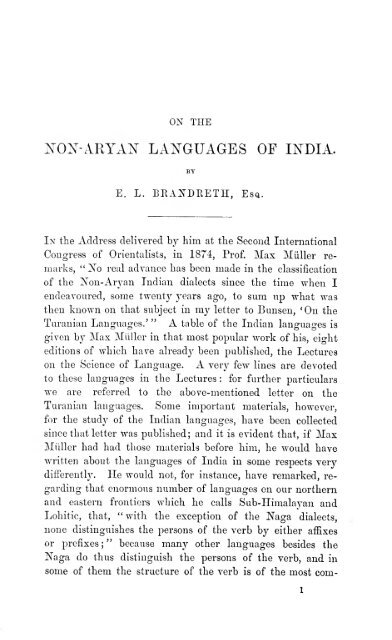Create successful ePaper yourself
Turn your PDF publications into a flip-book with our unique Google optimized e-Paper software.
ON THE<br />
^^ON-A^RYAISr LANGUAGES OF INDIA.<br />
BY<br />
E. L. BRAiN'DRETH, Esq.<br />
Ix <strong>the</strong> Address delivered by him at <strong>the</strong> Second International<br />
Congress <strong>of</strong> Orientalists, in 1874, Pr<strong>of</strong>. Max Miiller re-<br />
marks, " No real advance has been made in <strong>the</strong> classification<br />
<strong>of</strong> <strong>the</strong> Non- <strong>Aryan</strong> <strong>India</strong>n dialects since <strong>the</strong> time when I<br />
endeavoured, some twenty years ago, to sum up what was<br />
<strong>the</strong>n known on that subject in my letter to Bunsen, *0n <strong>the</strong><br />
Turanian Languages.' " A table <strong>of</strong> <strong>the</strong> <strong>India</strong>n <strong>languages</strong> is<br />
given by Max Miiller in that most popular work <strong>of</strong> his, eight<br />
editions <strong>of</strong> which have already been published, <strong>the</strong> Lectures<br />
on <strong>the</strong> Science <strong>of</strong> Language. A very few lines are devoted<br />
to <strong>the</strong>se <strong>languages</strong> in <strong>the</strong> Lectures : for fur<strong>the</strong>r particulars<br />
we are referred to <strong>the</strong> above-mentioned letter on <strong>the</strong><br />
Turanian <strong>languages</strong>. Some important materials, however,<br />
for <strong>the</strong> stud}?- <strong>of</strong> <strong>the</strong> <strong>India</strong>n <strong>languages</strong>, have been collected<br />
since that letter was published; and it is evident that, if Max<br />
Miiller had had those materials before him, he would have<br />
written about <strong>the</strong> <strong>languages</strong> <strong>of</strong> <strong>India</strong> in some respects very<br />
dilFerentl3\ He would not, for instance, have remarked, re-<br />
garding that enormous number <strong>of</strong> <strong>languages</strong> on our nor<strong>the</strong>rn<br />
and eastern frontiers which he calls Sub-Himalayan and<br />
Lohitic, that, "with <strong>the</strong> exception <strong>of</strong> <strong>the</strong> Naga dialects,<br />
<strong>non</strong>e distinguishes <strong>the</strong> persons <strong>of</strong> <strong>the</strong> verb by ei<strong>the</strong>r affixes<br />
or prefixes ;<br />
" because many o<strong>the</strong>r <strong>languages</strong> besides <strong>the</strong><br />
Naga do thus distinguish <strong>the</strong> persons <strong>of</strong> <strong>the</strong> verb, and in<br />
some <strong>of</strong> <strong>the</strong>m <strong>the</strong> structure <strong>of</strong> <strong>the</strong> verb is <strong>of</strong> <strong>the</strong> most com-

















